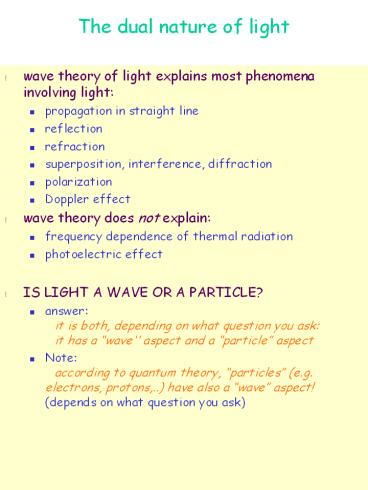The dual nature of light PowerPoint PPT Presentation
Title: The dual nature of light
1
The dual nature of light
- wave theory of light explains most phenomena
involving light - propagation in straight line
- reflection
- refraction
- superposition, interference, diffraction
- polarization
- Doppler effect
- wave theory does not explain
- frequency dependence of thermal radiation
- photoelectric effect
- IS LIGHT A WAVE OR A PARTICLE?
- answer it is both, depending on what
question you ask it has a wave' aspect and a
particle aspect - Note according to quantum theory,
particles (e.g. electrons, protons,..) have
also a wave aspect! (depends on what question
you ask)
2
Thermal radiation
- experimental observations
- atoms of a hot solid emit radiation
- increase in temperature ? more radiation, and
component of maximum intensity shifted towards
higher frequency (shorter wavelength) - classical explanation the hotter the
solid, the more vibrational energy ? higher
frequency of vibration of atoms/electrons ?
higher frequency of radiation - but frequency spectrum of this radiation (black
body radiation calculated within framework of
electromagnetism and thermodynamics did not agree
with measured spectrum - predicted ultraviolet catastrophe I ? f4
- Max Planck's hypothesis (1900) energy is
quantized oscillators (oscillating atoms)
can only have certain amounts of energy - relation between energy and frequency of
oscillator E h f, where h
Plancks constant 6.63x10-34 Js - calculation of black body spectrum using Planck's
hypothesis gives formula (Planck formula) which
describes measured spectra. - first evidence that energy is quantized
3
Photoelectric effect
- (first observed by Heinrich Hertz in 1887)
- electrons are emitted when certain metallic
materials exposed to light (now used in
photocells in cameras, and solar energy cells)
- some aspects of photoelectric effect could not be
explained by classical theory - classical theory if light continuos flow of e.m.
energy takes some (calculable) time for wave to
supply sufficient energy for electron to be
emitted - find experimentally current flows almost
immediately upon exposure to light - classical theory light of any frequency could
cause photoelectric effect - need only sufficient
intensity - find experimentally only light with frequency
above certain minimum frequency causes electrons
to be emitted - classical theory energy of electrons depends on
light intensity - find experimentally energy of electrons depends
on frequency - Albert Einstein's explanation
- assume that not only energy in atoms is
quantized, but also energy carried by light - light comes in packets of energy called light
quanta or photons - energy of one photon h f, where f frequency
of the light. - with this assumption, all aspects of
photoelectric effect could be explained - photon energy vs color of light E hf hc/?
? blue
light has more energy than red light

